Sailboat Tech – Lithium Batteries & Why We Chose Them
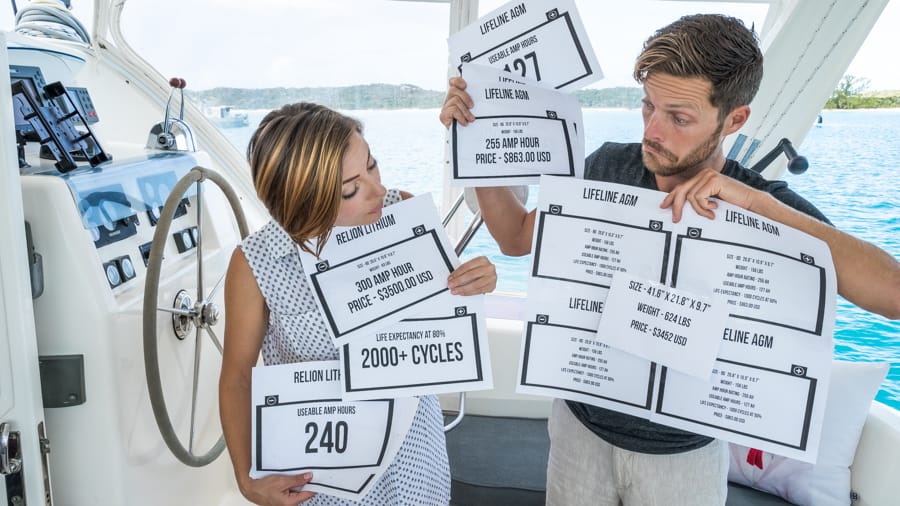
There is an old saying that batteries don’t die, they are killed. Sadly, this is true and we are guilty as charged. Ba-dum-bum-CHING! Sorry, I couldn’t help myself.
In all seriousness, we not only killed our first set of RV batteries, we tortured them daily and finally froze them to death. Why? We didn’t know any better. Without fully understanding how batteries work coupled with not having a battery monitoring kit, we were clueless, but that’s another story.
Fast forward seven years of trial and error and we’re practically off the grid pros. Ok, that may be a stretch, but we have become finely tuned into the resources we use and how to replenish them. Especially when it comes to our power needs.
Now that we are living aboard a sailboat, electricity has become our most important resource. I know that sounds crazy considering we use wind power to move our floating home but stick with me here.
It seems like everything aboard our catamaran requires electricity to function. Systems such as radios, instruments, autopilot, lights, bilge pumps and winches are all powered by electricity. Add in our refrigerator, freezer, water heater, air conditioning, cooking devices, cameras and so on…we practically need our own mobile power plant!
Or… A stellar set of lithium batteries.
Lithium batteries are by far the most important electrical upgrade on our sailboat. They are the heart of our power system supplying juice to each of our devices, just like our heart pumps blood through our bodies to vital organs.
Everything on our sailboat runs off the battery bank, not only while anchored out, but also while sailing with the engines off. Having a sufficient battery bank to supply those power needs is incredibly important. Having all the fancy electronics in the world on our boat won’t matter if we can’t power them.
Most Important Sailboat Tech Upgrade
That’s why we say lithium batteries are the most important upgrade on our boat. Once we’ve got solid power, then we can start thinking about all the fun stuff they can power. So, choosing lithium was a no brainer.
We made this video to help demonstrate why we think lithium batteries are awesome and why we chose them. Fair warning, this is not a full on technical analysis. We’re not experts, we’re two average people sharing our experiences and what we’ve learned along the way.
We hope that made some sense?! Below is a more organized version along with extra details we talked about.
Oh, and if you are wondering about my vacuum or Jason’s lithium drill, we do love them both and you can find them here:
- Vacuum: http://amzn.to/2niMPep
- Drill: http://amzn.to/2nj3iiU
Why Lithium vs AGM?
There is simply no comparison. Lithium batteries are leaps and bounds better, stronger, lighter, smaller, faster, safer, easier, greener and more powerful than lead acid or AGMs. Period. So why does anyone still buy them?
Money Talks
Price. There is a common misunderstanding that lithium is drastically more expensive than AGMs or lead acid batteries.
But first things first. Let’s eliminate flooded lead acid as an option. Lead acid batteries used to be the best and only option but we feel it has absolutely no place on a boat anymore. Toxic off gassing, storage issues (must be stored in a non living area, upright in well ventilated area) maintenance (topping off liquids once a month), lack of efficiency and safety risks make it a no go in today’s technology filled world.
We feel so strongly about this, we even swapped out our engine and generator batteries for lithium. You know, because they are stored right under where we sleep! How could we sleep well knowing lead acid batteries were off gassing toxic fumes under our mattress.
So that leaves us with AGM and Lithium as viable options. At first glance these batteries seem fairly similar: They are both “8D” size, the amp hours are similar…sure the AGM weighs about 40% more but the lithium battery looks grossly overpriced in comparison to the AGM. The sticker shock is enough to send anyone running, and trust me that is EXACTLY what we used to think.
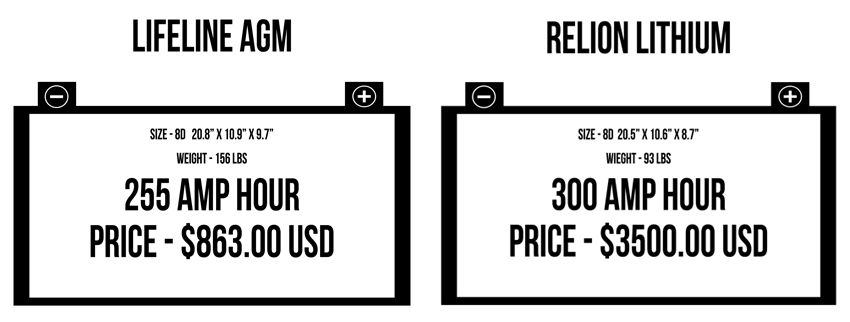
The problem here is the AMP hour conundrum. Lithium batteries are sooo drastically different from AGM and there is way more to consider than just the factory rated AMP hours printed on the spec sheet.
Useable AMP Hours
For our example, we’re looking at a Relion Lithium Battery (because that’s what we have) vs a Lifeline AGM Battery.
What we really need to be looking at when comparing any batteries is the useable amp hours, not the amp hours printed on the battery.
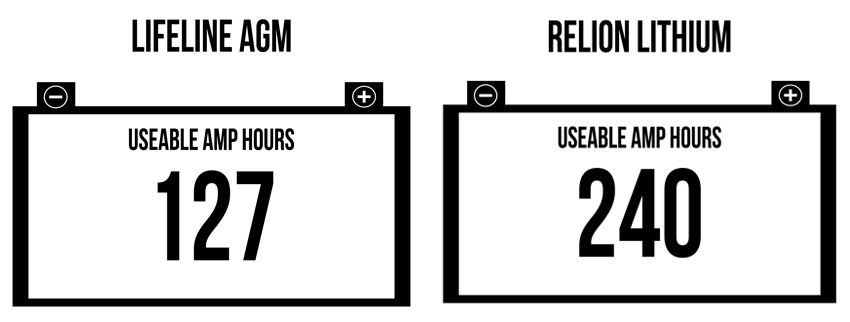
Looking at the useable amp hours we can clearly see that the AGM battery has almost half the useable amp hours of the lithium. So, to get a similar amount of useable amp hours we would need two AGM batteries to equal our one lithium battery.
Life Expectancy
The next big distinguishing factor between AGM and lithium batteries is the life expectancy. Lithium lasts at least twice as long as an AGM (and most likely triple and beyond). That means we would go through at least double the amount of AGM batteries during the lifespan of our lithium bank.
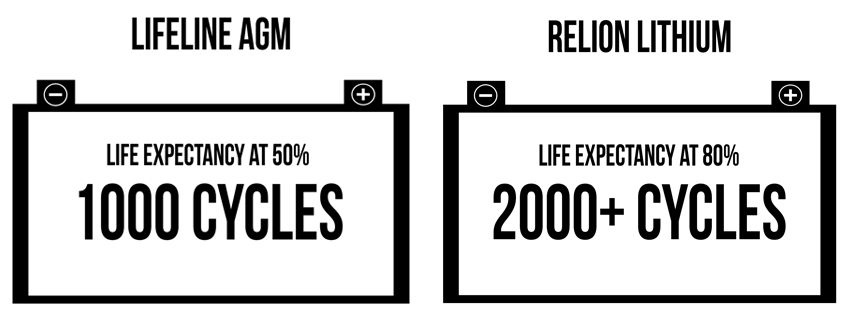
Looking no further than this, it’s easy enough to see that we would need at least four AGM batteries to have similar useage as our one lithium over time. So not only is that a lot more weight and space taken up, but now our price is now practically the same (probably cheaper if you consider installation costs times two).
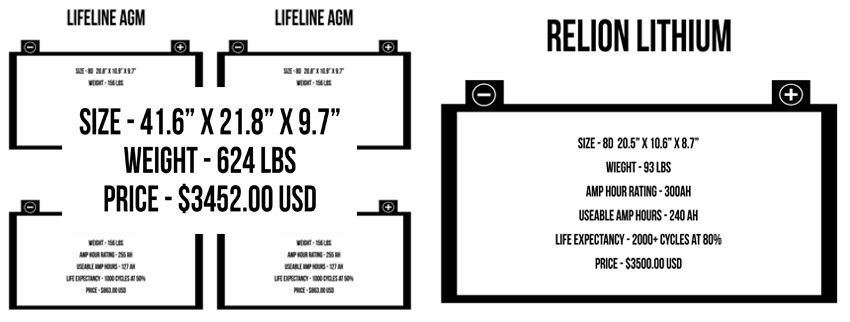
But let’s not stop there, because lithium still has a lot of bragging to do. Here are some of the other perks we get by going with lithium:
- Super Model Skinny – Lithium is almost half the weight of lead acid and takes up way less space per useable amp hour. This means more battery in less space…without the drama.
- How Low Can You Go – Lithium batteries can be discharged down to 10% or lower. Most lead acid and AGM batteries do not recommend more than 50% depth of discharge. Overall battery life is seriously affected by higher levels of discharge in AGM (and lead acid) yet only slightly affected in lithium batteries.
- Mad Efficient -Lithium batteries are 99% efficient meaning that they allow the same amount of amp hours both in and out. Lead acid batteries are less efficient and have a loss of 15 amps while charging and rapid discharging drops the voltage quickly and reduces the batteries’ overall capacity. AGM batteries are slightly better than Flooded Lead Acid but nowhere near as good as Lithium. (If you want to run high draw electronics like an Air Conditioner or water heater, you’ll want lithium batteries.)
- Suck It Up Fast – Lithium Batteries have very little internal resistance and almost no absorb time so they can suck up power and charge all the way to 100% really fast. With old school batteries, there is a 3-stage charging cycle: 1. bulk phase where you push in a bunch of power to get the battery to 80-90% charged. 2. absorb phase where charge is held back until the last 10% charge can be reached (this is because lead acid have a lot of internal resistance at this phase). 3. float phase where the charge voltage drops because the battery is full. It’s that 2nd absorb phase that holds things up big time. It can take a really long time to get the last 10%…like hours.
- Even Keeled – Lithium batteries maintain their voltage during use, which is better and more efficient for all our electrical devices. Lithium doesn’t care if it’s at 30% or 95% DOD and they won’t lose capacity with heavier loads. This is especially important for things like AC, electric cooking devices, water heaters, etc. that pull a lot of power. Lead acid and AGM batteries will drop voltage consistently throughout the discharge cycle, they’ll need to be fully charged on a regular basis and heavy loads will quickly suck the life out of them.
- Drama Free – Lithium requires no maintenance. I can’t imagine pulling off our cushion, clearing out the storage, removing the shelves and having to add distilled water (one more thing to have to carry and store) to all our batteries every couple of weeks or so. That would be a horrible pain in the you-know-what, and another great reason not to buy lead acid.
Safety
We’ve all heard about cell phones and computers with lithium batteries bursting into flames. Scary (especially considering we carry these items in our hands) but this isn’t the same type of lithium. Our lithium batteries are LiFePo4, it’s different technology and it’s way safer.
Our lithium batteries have nifty circuitry built in that keeps the battery pack safe and under control. It’s called the battery monitoring system. Reputable lithium battery companies have lots of systems in place to make sure each battery has a BMS installed and is configured correctly. We’ve seen firsthand what can happen when this very important step is ignored (that story coming soon).
Go For A Good Warranty
Whichever brand of battery you choose, make sure it has a solid warranty. Also, make sure it’s from a company that is going to be around for a long while in case you ever need to take them up on that warranty. Too many companies come and go leaving you stranded with no warranty and no customer service (sadly, we have experienced this).
Warranty was a big factor as to why we chose to install Relion on our sailboat. Relion Lithium Batteries come with a 5-year warranty but Just Catamarans is a distributor and installer for Relion. By having our batteries installed by them, we gained an additional 2 years on our lithium battery warranty, giving us a total of 7 years.
Global Support
Another thing we had to consider when looking into batteries was global support. We didn’t want to end up at some other point around the globe, have an issue and not be able to get support, service or warranty. If you plan on travelling about the world as well, its something to think about when deciding which brand to go with.
Our Battery Bank
We have four 12V 300AH ($3497 each) batteries for our house bank and a 12V 100AH ($1297 each) battery for each of our engines and generator start batteries. That’s right, 4 lithium batteries for our house bank and 3 separate lithium batteries for our starting batteries. Combine this with our 1200 watts of solar and we find this keeps us going no problem and we very rarely need to run our generator. That said, we have not been running our AC because the temps have been perfect here in the Bahamas. It’s also good to know that we do have to run our gene every 3-4 days to run our watermaker (because its not 12v). We have been in ideal conditions with sunshine at least every other day or so. We will go into more details later on what all we use in a day, how we manage our useage and how our solar does at keeping up with our power hungry lifestyle.
Want a discount on Lithium Batteries?
We did reach out and ask Relion (more than once) if we could get you guys a discount but sadly we were told no. Relion is already affordably and competitively priced so I understand why they don’t like offering up special discount codes. However, Just Catamarans did step-up and said they would hook you up. Maybe you want some free days of dockage or a free install…give them a call and tell them “The Wynns said you would give me a really good deal”. They are big on customer service and keeping their word (and they did tell us that), so it should do the trick.
Still not convinced or need more info?
Check out these posts from our fellow traveling gurus who also made the switch and talk about why:
- Technomadia, RV’ers and Motorboaters (these guys were super early adopters and have loads of geeky good info and built their own lithium bank): technomadia.com/lithium/
- Wheeling It, RV’ers Nina and Paul – wheelingit.us/2016/02/24/the-big-beastly-solarbattery-upgrade-part-i-why/
- JenEric Ramblings, RV’ers with a great DIY install post – jenericramblings.com/2017/01/17/rv-upgrades-switching-to-lithium/
- Luna Sea, Sailors Mark and Jennifer – sailinglunasea.com/upgrading-the-batteries-lithium-ion-on-a-sailboat/
What’s next?
Well, now that you have the scoop on our sailboat lithium battery bank, what do you want to know about next? What burning sailboat tech questions do you have for us? Let us know what you are most interested in and that’s what we will cover next.
Feeling Tipsy?
Thank you soooo very much for watching, reading and hanging out with us here! If you found this helpful, or at least as entertaining as battery talk can be, and want to say thanks or leave a tip? We have a Say Thanks page that lists out some ways you can show us some digital love and most won’t cost you a penny.




